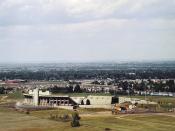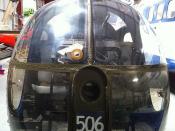Ted Hughes is a renowned, restrained poet for his ability to be intricate, and his concealment of emotion in insignificant forms of life. In the poem, Thistles, Hughes personalizes Thistles; such trivial plant, to successfully evoke the lives of human beings, while emphasizing nature's dominance over men. The poem also deals with the idea of history being repeated in a cycle, the dead being "resurrected". Such complex ideas are effectively conveyed through language techniques, diction and versification.
"Thistles" is an insignificant form of life, which are generally disregarded by other superior forms of life (cows and farmers), losing its' identity of existence. However the poet personifies the plant, giving it life. 'Thistles' begins with a description of the location of the trivial plant and it's physical appearance. "Against the rubber tongues of cows and the hoeing hands of men / Thistles spike the summer air / And crackle open under a blue-black pressure."
The thistles are situated in a field amidst cows and farmers, yet among such serene background, they appear to have an aggressive purpose. Alliteration is present, "Blue-black" with the repetition of the 'b' sound, emphasizing the immense pressure they are in, the Thistles literally bursting with reproductive energy. Also, the alliteration implies the imagery of a bruise, caused by a physical contact.
Then it is seen that the thistles pollinate and reproduce: "Every one a revengeful burst". This conveys that there is a motive, a reason, for the reproduction; other than simply to maintain its species. The motive is to fight a battle, a continuous war. Hughes has given the thistles human features and emotions, such as the ability to take revenge. Through personifying such inconsequential organism, Hughes expresses his speculation of how, even the petty forms of life has it's...


